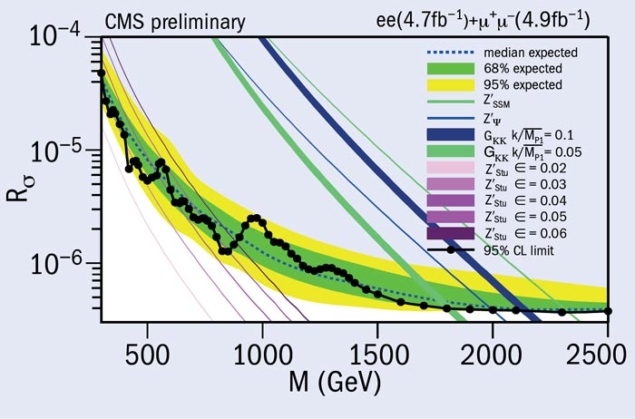The ATLAS and CMS collaborations are carrying out a large-scale hunt for hypothetical heavy partners of the Standard Model gauge bosons, the W and the Z. The two experiments were designed to be sensitive to the decays of such particles, which are called, appropriately, W’ and Z’. The latest findings presented at the recent winter conferences show that so far these searches probe for W’ and Z’ particles with masses more than 20 times larger than those of their well known Standard Model counterparts.
The W and Z bosons, mediators of the weak force, are almost 100 times heavier than the proton. Their discovery, which was announced in 1983, had awaited the conversion of CERN’s Super Proton Synchrotron into a proton–antiproton collider to form the first machine energetic enough to produce them. Various theories provide motivation for the heavier W’ and Z’ bosons, and their existence would provide answers to many fundamental questions. For example, the extreme weakness of gravity – when compared with electromagnetism – could be explained by theories that include additional spatial dimensions and in which new heavy particles like a Z’ appear.

Strongly motivated by such theoretical arguments, physicists at the LHC have been hunting for these heavy partners of the W and Z since the collider started up. Many theories predict that the new gauge bosons would be similar to their light partners, only with larger masses. For example, the Z’ boson could decay to a lepton–antilepton pair, the same channel in which the Z was discovered. ATLAS and CMS have carefully analysed all such events and classified them into mass distributions, such as the one in figure 1 for dimuons in the ATLAS experiment. The black points represent the data and the coloured areas represent contributions expected in the Standard Model. The prominent feature is the Z-boson peak on the left side of the spectrum. If a Z’ boson exists, it should peak in a similar manner somewhere on the right, in the mass region around 1500–2000 GeV, as shown by the thin coloured lines.

No clear evidence of the Z’ or W’ bosons has yet been observed, so the collaborations calculate the mass range where the existence of a hypothetical W’ or Z’ boson is excluded with 95% probability. Figure 2 shows the maximum allowed production rate (black points) as a function of the hypothetical Z’ boson mass, as allowed by the CMS data. The different theories, shown by continuous coloured lines, are excluded in the low-mass region where they predict a rate larger than that shown with the black line, but are still allowed in the high-mass region where they predict a lower rate. For example, the Standard Model-like Z’ boson predicted by the Sequential Standard Model is excluded up to 2300 GeV (2.3 TeV).
It might also be the case that the preferred decay channels of the Z’ bosons are different from those of the Z boson. For instance, the Z’ may prefer to decay into pairs of quarks or even a pair of the lighter partners – the W and Z of the Standard Model. It is therefore critical to explore all of the possible decay channels. These searches are about to be completed by the two collaborations using large data samples collected during the 2010–2011 runs. At the same time they are eagerly awaiting the 2012 data, with larger data samples of even more energetic collisions provided by the LHC. The hunt will then start anew and probe even higher masses
Further reading
CMS collaboration 2011 Phys. Lett. B704 123; https://twiki.cern.ch/twiki/bin/view/CMSPublic/PhysicsResultsEXO11019Winter2012.
ATLAS collaboration 2011 Phys. Rev. Lett. 107 272002; ATLAS-CONF-2012–007.





